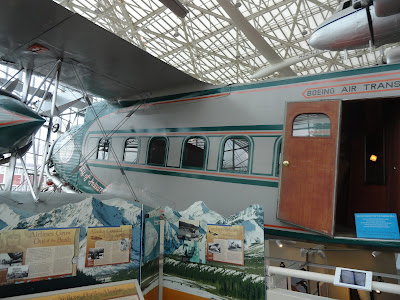Hi Everyone..!! Hope you had enjoyed reading part 1. In case, you had missed it go to the link below.
link: Part 1
The following post contains the details of different exhibits inside the Museum of Flights building.
Detailed explanations of each plane would be in separate post.
When you enter the museum you will find 3 paths. One will lead you to the aircraft gallery, Other leads to the WW2 aircraft gallery & the last path leads to a bridge which transfers to the other side of the road where there is gallery of space modules.
Panoramic View of Aircraft Gallery of the Museum of Flight
Boeing Tower at Museum of Flight
Here you can hear the live communication between the ATC & pilots in that region
Aircraft inside the Museum of Flight
1. Lockheed M-21 BlackBird
The Blackbird family of aircraft cruise at speeds of more than Mach 3 and fly over 85,000 feet (25,500 m) in altitude. Conceived nearly 50 years ago, Blackbirds remain the fastest and highest flying air-breathing production aircraft ever built.
This M-21 is a unique variant of the A-12, the earliest Blackbird type. Built for a CIA program code-named "Tagboard," the M-21 carried unpiloted vehicles for intelligence gathering. These drones were intended for launch from the M-21 "mother ship" for flights over hostile territories. Design features of the M-21 include the second seat for the Launch Control Officer and the launch pylon on which the drone is mounted.
2.Boeing 80A
Also Known as "Pioneer Pullman of the Air"
Until the mid-1920s, American commercial airplanes were built for mail, not people. Boeing's Model 80, along with the Ford and Fokker tri-Motors, were a new breed of passenger aircraft. The 80 first flew in August 1928 and was working along Boeing Air Transport's route two weeks later. The 12-passenger Model 80 and the more-powerful 18-passenger 80A (re-designated 80A-1s when the tail surfaces were modified in 1930) stayed in service until 1933, when replaced by the all-metal Boeing Model 247.
The Museum's Model 80A-1, equipped with three Pratt & Whitney 525-horsepower "Hornet" engines, was retired from service with United in 1934. In 1941, it became a cargo aircraft with a construction firm in Alaska. To carry large equipment, including a massive 11,000-pound (4,950 kg) boiler, a cargo door was cut into the plane's side. After the war, the 80 was stored and then discarded. It was recovered from a dump in 1960 and eventually brought to Seattle for restoration. It is the only surviving example of the Boeing Model 80 series.
3.Lockheed 21B Drone
The D-21 drone was an unpiloted aircraft originally designed for CIA and Air Force surveillance missions over particularly hostile territories. Launched from airborne carrier aircraft, the D-21's Marquardt RJ43-MA-11 ramjet engine propelled it at speeds over 2,000 mph. (3,200 km/h). The two Lockheed M-21 Blackbird "mother ships" were designated M/D-21s when the D-21 "daughter" drone was mounted on top.
4.Bell "Huey" UH-1H Iroquois
The Bell UH-1 Iroquois, commonly known as the "Huey", is perhaps most famous for its extensive use during the Viet Nam War. The first Hueys began arriving in Viet Nam in 1962. There they served in medical evacuation (MEDEVAC), transport, aerial assault and general utility roles for the U.S. Army, Air Force, Navy and Marine Corps.
5.Douglas A-4F Skyhawk II
The nimble and speedy A-4 that wowed audiences with the Blue Angels for 13 seasons bucked the trend of "bigger is better." In 1952, Douglas designer Ed Heinemann, who had been the company's Chief Engineer since 1937, proposed that the Navy's newest attack plane be smaller, lighter, and faster than its contemporaries. Starting in 1956, the little but powerful A-4 flew with Navy and Marine units, including flying combat missions during the Vietnam War. Heinemann's A-4 design surpassed all of the Navy's requirements for a light attack aircraft at about half the requested size and weight. A little package with a powerful punch created many advantages over larger Navy planes. The A-4s were easy to manage on an aircraft carrier deck and their stubby modified delta wings didn't need to be folded for storage. Without the wing-folding mechanisms, the Skyhawk was even lighter and simpler to maintain -- aspects that allowed it to stay in operational service for over 35 years. The Skyhawk had one of the longest production runs of any American combat aircraft, with 2,960 built over 26 years.
6.Good Year F2G-1 Super Corsair
Big, robust, and fast, the Goodyear F2G was often referred to as the "Super Corsair" for good reason. Designed and produced by Goodyear rather than Vought, the F2G design mated the Corsair airframe to Pratt & Whitney's huge R-4360 engine rated at 3,000 horsepower. Other changes were a bubble canopy and a taller vertical stabilizer with auxiliary rudder to compensate for the engine's extra torque. Some 418 F2Gs were ordered, but only five F2G-1s and five folding-wing "dash twos" were manufactured.
The Museum's F2G-1 Corsair, Navy Bureau of Aeronautics number 88454, was delivered in 1945. As the first production F2G-1, it spent most of its career at the Navy Air Test Center at Patuxent River, it then went into storage at Norfolk, Virginia, the Corsair with only 246 hours flight time.
Part 3: Click Here














No comments:
Post a Comment